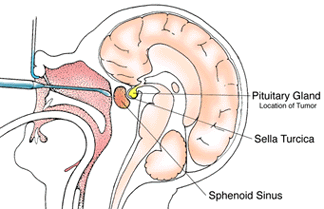Located at the base of the brain, the pituitary gland is responsible for regulating the body's hormones. Tumors in pituitary gland are usually pituitary adenomas and grow slowly. They are relatively common and affect one in five adults. Most of these tumors are benign growths and rarely cause any problems. These tumors are usually found when a patient undergoes an MRI scan of the brain due to another problem. You usually need pituitary adenoma surgery when these tumors cause any problems.
When Is Surgery Needed?
As mentioned, pituitary adenomas usually do not cause problems, but it is a good idea to have them removed when they are in a part of the brain where neurosurgeons can remove it safely. You might be a suitable candidate for surgery if your tumor is:
- Producing hormones that cannot be controlled with medications
- Causing health problems by affecting your nervous system
- Growing even after taking medications
Types of Pituitary Adenoma Surgery
Surgery is usually the only treatment available for pituitary tumors. What type of tumor you have, what its exact location is, how big it is, etc., are some of the factors determining how effective the surgery will prove. Your doctor may opt for one of two types of surgeries.

1. Transsphenoidal Surgery
This is the most common surgical procedure to remove pituitary tumors. Your surgeon performs the surgery through a hollow space in the skull called the sphenoid sinus, which is below the brain and behind the nasal passages.
The procedure involves using an endoscope and a think fiber-optic tube equipped with a tiny camera. It is inserted through a small incision made in the back of the nasal septum to remove the tumor. Sometimes, the location of the tumor makes this technique ineffective, which is when a small incision is made under the upper lip to open the walls of the sphenoid sinus and reach the tumor.
2. Craniotomy
A craniotomy is usually performed in case of a more complicated pituitary tumor. It involves operating through a very small opening in the side and front of the skull. The procedure is rather effective for complex lesions, but has a higher chance of brain injury, especially compared to transsphenoidal surgery. Your surgeon may make use of CT scans or MRIs to help determine the exact location of a tumor.
Possible Risks Involved
Pituitary adenoma surgery is a complex procedure and requires surgeons to be very careful during and after surgery. There are always chances of experiencing complications, such as infections, bleeding, or reactions to anesthesia. A sinus headache is a common side effect for people who undergo transsphenoidal surgery – it usually goes away within a couple of weeks after surgery.
During surgery, it is possible to sustain damage to large arteries, brain tissue, and nerves near the pituitary gland. This can cause brain damage and even result in blindness. Some people may develop diabetes insipidus after surgery. It usually improves within a couple of weeks, but it can be permanent in some cases. A desmopressin nasal spray is recommended in this case.
It is possible to develop meningitis, an infection of meninges, after surgery. That is mainly because your surgeon has to create a temporary pathway between the brain and the nasal sinuses. Similarly, any other damage to the pituitary gland can cause other symptoms due to a lack of pituitary hormones. Your doctor may give you certain medicines to raise pituitary hormone levels.
Pituitary Adenoma Surgery Recovery Tips
You are usually free to go home after a couple of days of your surgery, but you need to keep several things in mind to accelerate recovery. For instance:
- You should increase your fluid intake to prevent dehydration – you should drink fluids even when you have diabetes insipidus because drinking less is not going to help either.
- It is important to inform your doctor if you have a cerebrospinal fluid leak, which refers to the leakage of a clear water fluid from the nose. You may also have a salty taste in your mouth with a feeling of fluid in the back of your throat. It is important to inform your doctor about these symptoms because this could lead to meningitis or other complications.
- You should avoid heavy lifting after your surgery. Do not lift anything heavier than 10 pounds at least for a month after your surgery. Similarly, you should not blow your nose and avoid straining as much as possible.
- Be sure to take Cortef until your doctor asks you to stop. Never stop taking Cortef suddenly or else you may develop certain issues, including headache, nausea, fatigue, and a general aching feeling. Inform your doctor in case you experience any such symptoms.
- Be sure to ask your doctor about follow-up appointments. Never miss those appointments and discuss your symptoms with your healthcare provider. You may have to see your neurosurgeon after two weeks of surgery – it is also important to visit your endocrinologist after six weeks of surgery. Your doctor may order an MRI scan after three months of your surgery.
